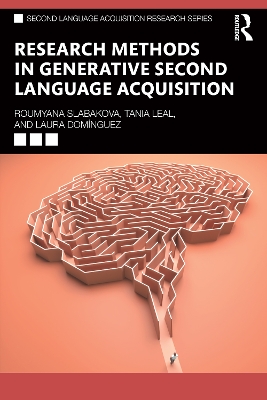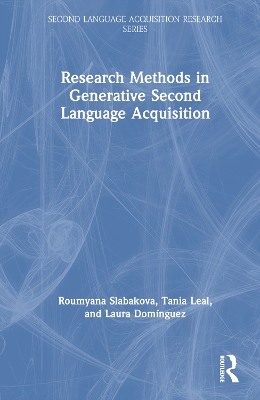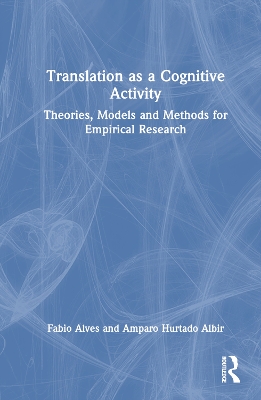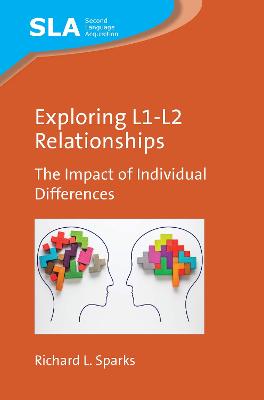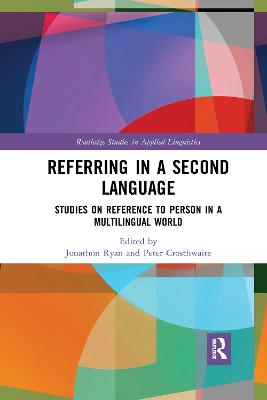Discourse Markers in Second Language French
 portes grátis
portes grátis
Discourse Markers in Second Language French
Reaves, Alisha
Taylor & Francis Ltd
10/2024
168
Mole
9781032347677
Pré-lançamento - envio 15 a 20 dias após a sua edição
Descrição não disponível.
TABLE OF CONTENTS
List of Tables
List of Figures
Acknowledgements
1. Introduction
1.1 Discourse Markers in French Society
1.2 Discourse Markers in the L2 Classroom
1.3 Learner Challenges in Acquiring Discourse Markers
1.4 Motivations for Studying L2 Discourse Marker Development
1.5 Organization of the Book
1.6 References
2. What are Discourse Markers?
2.1 Terminological Debates
2.2 Key Characteristics of Discourse Markers
2.3 What (for practical purposes) Counts as a Discourse Marker?
2.4 Discourse Markers and Position
2.5 Discourse Marker Combinations
2.6 Defining Discourse Markers for this Study
2.7 References
3. Functions of Common French Discourse Markers
3.1 Introduction
3.2 Alors
3.3 Ben
3.4 Bon
3.5 Donc
3.6 En effet
3.7 En fait
3.8 Enfin
3.9 Hein
3.10 Mais
3.11 Oui
3.12 Parce que
3.13 Puis
3.14 Quoi
3.15 Tu sais
3.16 Voila
3.17 References
4. What Do We Already Know about L2 Discourse Marker Use?
4.1 Five Conclusions Drawn from L2 Discourse Marker Research to Date
4.2 Can L1 Transfer Explain Learner Discourse Marker Production?
4.3 What Sociolinguistic Variables Affect Discourse Marker Use in the L2?
4.4 What is the Effect of Study Abroad?
4.5 (How) Do Learners Process Discourse Markers that They Hear?
4.6 Can Discourse Markers Be Taught?
4.7 Refocusing on L2 French Discourse Markers
4.8 Conclusion
4.9 References
5. Methodological Questions in L2 Discourse Marker Research
5.1 Introduction
5.2 Contrastive or Interlanguage Analysis?
5.3 Form-to-function or function-to-form?
5.4 The Effects of Tasks and Instruments
5.5 The Current Study
5.6 Conclusion
5.7 References
6. How Do Native Speakers Use Discourse Markers?
6.1 Introduction
6.2 What is the Inventory of Discourse Markers Used by the Native Speakers of French in this Study?
6.3 What is the Functional Distribution of Discourse Markers for Native Speakers in this Corpus?
6.4 Syntactic Considerations
6.5 Sociolinguistic Considerations
6.6 Conclusion
6.7 References
7. How Do Learners of French use Discourse Markers?
7.1 Introduction
7.2 What is the Inventory of Discourse Markers used by Learners of French?
7.3 What is the Distribution of DM to function and How Does the Inventory of DMs and their Functions Change over Time?
7.4 Syntactic Considerations
7.5 Sociolinguistic Considerations
7.6 Conclusion
7.7 References
8. New Insights and Next Steps in L2 Discourse Marker Research
8.1 Introduction
8.2 Primary Findings of this Study
8.3 Other Contributing Factors to L2 Discourse Marker Acquisition
8.4 What can L2 Acquisition Tell us about the Nature of Discourse Markers?
8.5 Methodological and Pedagogical Implications
8.6 References
9. Conclusion
9.1 Concluding Remarks
9.2 Future Directions
9.3 References
10. Appendices
Appendix A - Participant Profiles
Appendix B - Native Speaker Discourse Marker Inventory
Appendix C - Learner Discourse Marker Inventory
References
Index
List of Tables
List of Figures
Acknowledgements
1. Introduction
1.1 Discourse Markers in French Society
1.2 Discourse Markers in the L2 Classroom
1.3 Learner Challenges in Acquiring Discourse Markers
1.4 Motivations for Studying L2 Discourse Marker Development
1.5 Organization of the Book
1.6 References
2. What are Discourse Markers?
2.1 Terminological Debates
2.2 Key Characteristics of Discourse Markers
2.3 What (for practical purposes) Counts as a Discourse Marker?
2.4 Discourse Markers and Position
2.5 Discourse Marker Combinations
2.6 Defining Discourse Markers for this Study
2.7 References
3. Functions of Common French Discourse Markers
3.1 Introduction
3.2 Alors
3.3 Ben
3.4 Bon
3.5 Donc
3.6 En effet
3.7 En fait
3.8 Enfin
3.9 Hein
3.10 Mais
3.11 Oui
3.12 Parce que
3.13 Puis
3.14 Quoi
3.15 Tu sais
3.16 Voila
3.17 References
4. What Do We Already Know about L2 Discourse Marker Use?
4.1 Five Conclusions Drawn from L2 Discourse Marker Research to Date
4.2 Can L1 Transfer Explain Learner Discourse Marker Production?
4.3 What Sociolinguistic Variables Affect Discourse Marker Use in the L2?
4.4 What is the Effect of Study Abroad?
4.5 (How) Do Learners Process Discourse Markers that They Hear?
4.6 Can Discourse Markers Be Taught?
4.7 Refocusing on L2 French Discourse Markers
4.8 Conclusion
4.9 References
5. Methodological Questions in L2 Discourse Marker Research
5.1 Introduction
5.2 Contrastive or Interlanguage Analysis?
5.3 Form-to-function or function-to-form?
5.4 The Effects of Tasks and Instruments
5.5 The Current Study
5.6 Conclusion
5.7 References
6. How Do Native Speakers Use Discourse Markers?
6.1 Introduction
6.2 What is the Inventory of Discourse Markers Used by the Native Speakers of French in this Study?
6.3 What is the Functional Distribution of Discourse Markers for Native Speakers in this Corpus?
6.4 Syntactic Considerations
6.5 Sociolinguistic Considerations
6.6 Conclusion
6.7 References
7. How Do Learners of French use Discourse Markers?
7.1 Introduction
7.2 What is the Inventory of Discourse Markers used by Learners of French?
7.3 What is the Distribution of DM to function and How Does the Inventory of DMs and their Functions Change over Time?
7.4 Syntactic Considerations
7.5 Sociolinguistic Considerations
7.6 Conclusion
7.7 References
8. New Insights and Next Steps in L2 Discourse Marker Research
8.1 Introduction
8.2 Primary Findings of this Study
8.3 Other Contributing Factors to L2 Discourse Marker Acquisition
8.4 What can L2 Acquisition Tell us about the Nature of Discourse Markers?
8.5 Methodological and Pedagogical Implications
8.6 References
9. Conclusion
9.1 Concluding Remarks
9.2 Future Directions
9.3 References
10. Appendices
Appendix A - Participant Profiles
Appendix B - Native Speaker Discourse Marker Inventory
Appendix C - Learner Discourse Marker Inventory
References
Index
Este título pertence ao(s) assunto(s) indicados(s). Para ver outros títulos clique no assunto desejado.
Discourse Marker;Dm Dm;Frequent Discourse Marker;Native Speakers;English Discourse Marker;High Proficiency Group;Lower Proficiency Learners;Low Proficiency Group;Role Play Scenarios;L2 Italian;L2 Learner;Interlanguage Analysis;L1 Chinese Speaker;L2 French;Narrative Retell;Turn Management;Native Speaker Production;Film Discussion;L2 Acquisition;Cloze Test;L1 Chinese Learner;L1 Transfer;Speaker Hearer Relationship;Inter-group Heterogeneity;Aller Sur
TABLE OF CONTENTS
List of Tables
List of Figures
Acknowledgements
1. Introduction
1.1 Discourse Markers in French Society
1.2 Discourse Markers in the L2 Classroom
1.3 Learner Challenges in Acquiring Discourse Markers
1.4 Motivations for Studying L2 Discourse Marker Development
1.5 Organization of the Book
1.6 References
2. What are Discourse Markers?
2.1 Terminological Debates
2.2 Key Characteristics of Discourse Markers
2.3 What (for practical purposes) Counts as a Discourse Marker?
2.4 Discourse Markers and Position
2.5 Discourse Marker Combinations
2.6 Defining Discourse Markers for this Study
2.7 References
3. Functions of Common French Discourse Markers
3.1 Introduction
3.2 Alors
3.3 Ben
3.4 Bon
3.5 Donc
3.6 En effet
3.7 En fait
3.8 Enfin
3.9 Hein
3.10 Mais
3.11 Oui
3.12 Parce que
3.13 Puis
3.14 Quoi
3.15 Tu sais
3.16 Voila
3.17 References
4. What Do We Already Know about L2 Discourse Marker Use?
4.1 Five Conclusions Drawn from L2 Discourse Marker Research to Date
4.2 Can L1 Transfer Explain Learner Discourse Marker Production?
4.3 What Sociolinguistic Variables Affect Discourse Marker Use in the L2?
4.4 What is the Effect of Study Abroad?
4.5 (How) Do Learners Process Discourse Markers that They Hear?
4.6 Can Discourse Markers Be Taught?
4.7 Refocusing on L2 French Discourse Markers
4.8 Conclusion
4.9 References
5. Methodological Questions in L2 Discourse Marker Research
5.1 Introduction
5.2 Contrastive or Interlanguage Analysis?
5.3 Form-to-function or function-to-form?
5.4 The Effects of Tasks and Instruments
5.5 The Current Study
5.6 Conclusion
5.7 References
6. How Do Native Speakers Use Discourse Markers?
6.1 Introduction
6.2 What is the Inventory of Discourse Markers Used by the Native Speakers of French in this Study?
6.3 What is the Functional Distribution of Discourse Markers for Native Speakers in this Corpus?
6.4 Syntactic Considerations
6.5 Sociolinguistic Considerations
6.6 Conclusion
6.7 References
7. How Do Learners of French use Discourse Markers?
7.1 Introduction
7.2 What is the Inventory of Discourse Markers used by Learners of French?
7.3 What is the Distribution of DM to function and How Does the Inventory of DMs and their Functions Change over Time?
7.4 Syntactic Considerations
7.5 Sociolinguistic Considerations
7.6 Conclusion
7.7 References
8. New Insights and Next Steps in L2 Discourse Marker Research
8.1 Introduction
8.2 Primary Findings of this Study
8.3 Other Contributing Factors to L2 Discourse Marker Acquisition
8.4 What can L2 Acquisition Tell us about the Nature of Discourse Markers?
8.5 Methodological and Pedagogical Implications
8.6 References
9. Conclusion
9.1 Concluding Remarks
9.2 Future Directions
9.3 References
10. Appendices
Appendix A - Participant Profiles
Appendix B - Native Speaker Discourse Marker Inventory
Appendix C - Learner Discourse Marker Inventory
References
Index
List of Tables
List of Figures
Acknowledgements
1. Introduction
1.1 Discourse Markers in French Society
1.2 Discourse Markers in the L2 Classroom
1.3 Learner Challenges in Acquiring Discourse Markers
1.4 Motivations for Studying L2 Discourse Marker Development
1.5 Organization of the Book
1.6 References
2. What are Discourse Markers?
2.1 Terminological Debates
2.2 Key Characteristics of Discourse Markers
2.3 What (for practical purposes) Counts as a Discourse Marker?
2.4 Discourse Markers and Position
2.5 Discourse Marker Combinations
2.6 Defining Discourse Markers for this Study
2.7 References
3. Functions of Common French Discourse Markers
3.1 Introduction
3.2 Alors
3.3 Ben
3.4 Bon
3.5 Donc
3.6 En effet
3.7 En fait
3.8 Enfin
3.9 Hein
3.10 Mais
3.11 Oui
3.12 Parce que
3.13 Puis
3.14 Quoi
3.15 Tu sais
3.16 Voila
3.17 References
4. What Do We Already Know about L2 Discourse Marker Use?
4.1 Five Conclusions Drawn from L2 Discourse Marker Research to Date
4.2 Can L1 Transfer Explain Learner Discourse Marker Production?
4.3 What Sociolinguistic Variables Affect Discourse Marker Use in the L2?
4.4 What is the Effect of Study Abroad?
4.5 (How) Do Learners Process Discourse Markers that They Hear?
4.6 Can Discourse Markers Be Taught?
4.7 Refocusing on L2 French Discourse Markers
4.8 Conclusion
4.9 References
5. Methodological Questions in L2 Discourse Marker Research
5.1 Introduction
5.2 Contrastive or Interlanguage Analysis?
5.3 Form-to-function or function-to-form?
5.4 The Effects of Tasks and Instruments
5.5 The Current Study
5.6 Conclusion
5.7 References
6. How Do Native Speakers Use Discourse Markers?
6.1 Introduction
6.2 What is the Inventory of Discourse Markers Used by the Native Speakers of French in this Study?
6.3 What is the Functional Distribution of Discourse Markers for Native Speakers in this Corpus?
6.4 Syntactic Considerations
6.5 Sociolinguistic Considerations
6.6 Conclusion
6.7 References
7. How Do Learners of French use Discourse Markers?
7.1 Introduction
7.2 What is the Inventory of Discourse Markers used by Learners of French?
7.3 What is the Distribution of DM to function and How Does the Inventory of DMs and their Functions Change over Time?
7.4 Syntactic Considerations
7.5 Sociolinguistic Considerations
7.6 Conclusion
7.7 References
8. New Insights and Next Steps in L2 Discourse Marker Research
8.1 Introduction
8.2 Primary Findings of this Study
8.3 Other Contributing Factors to L2 Discourse Marker Acquisition
8.4 What can L2 Acquisition Tell us about the Nature of Discourse Markers?
8.5 Methodological and Pedagogical Implications
8.6 References
9. Conclusion
9.1 Concluding Remarks
9.2 Future Directions
9.3 References
10. Appendices
Appendix A - Participant Profiles
Appendix B - Native Speaker Discourse Marker Inventory
Appendix C - Learner Discourse Marker Inventory
References
Index
Este título pertence ao(s) assunto(s) indicados(s). Para ver outros títulos clique no assunto desejado.
Discourse Marker;Dm Dm;Frequent Discourse Marker;Native Speakers;English Discourse Marker;High Proficiency Group;Lower Proficiency Learners;Low Proficiency Group;Role Play Scenarios;L2 Italian;L2 Learner;Interlanguage Analysis;L1 Chinese Speaker;L2 French;Narrative Retell;Turn Management;Native Speaker Production;Film Discussion;L2 Acquisition;Cloze Test;L1 Chinese Learner;L1 Transfer;Speaker Hearer Relationship;Inter-group Heterogeneity;Aller Sur

